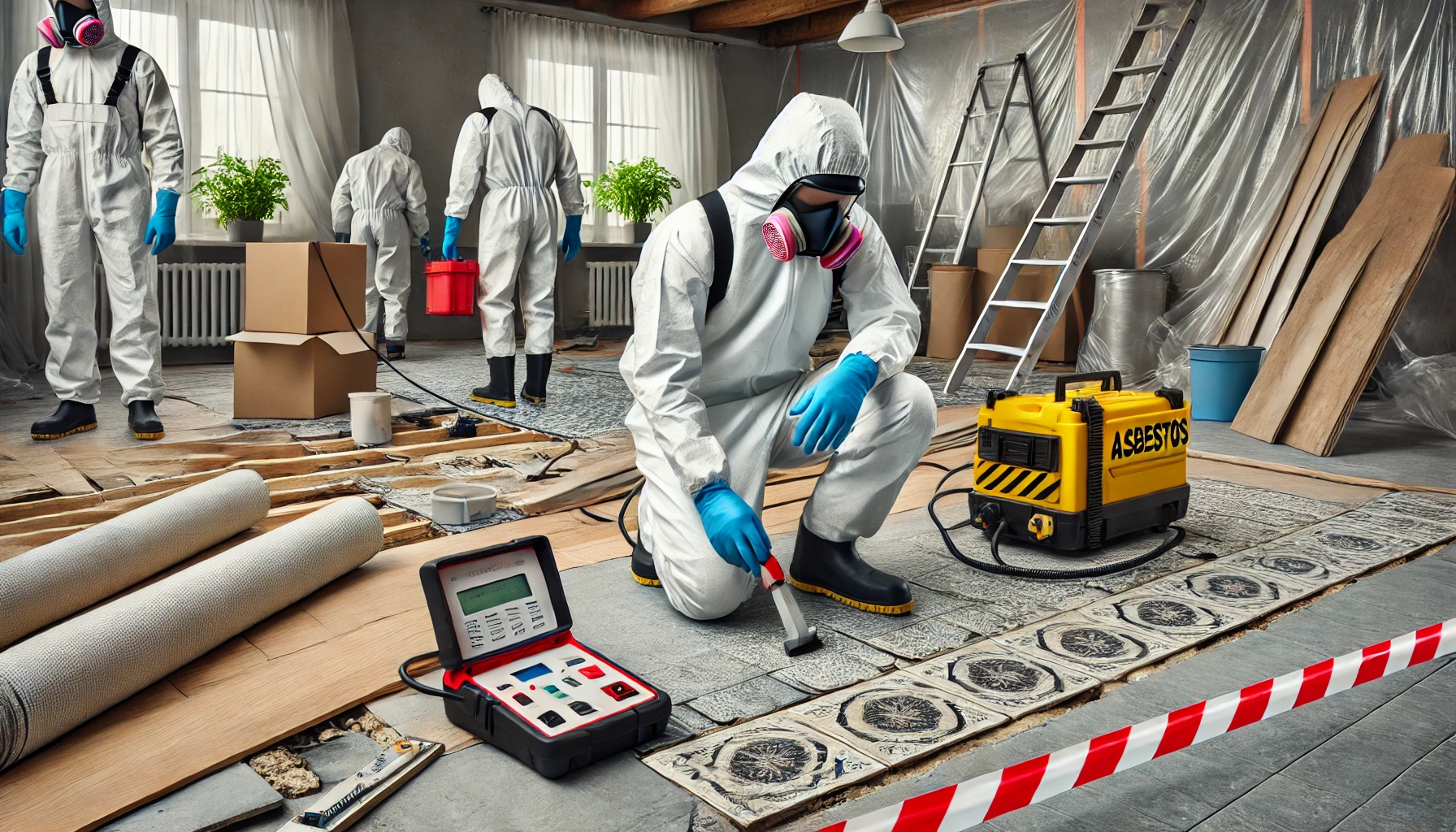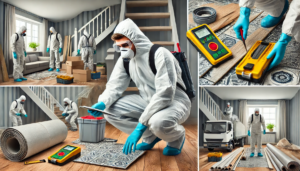
How Do You Tell If the Flooring Is Asbestos and How to Remove It?
Asbestos was a common component in many building materials throughout the 20th century, valued for its durability and fire-resistant properties. However, its use has significantly declined due to the severe health risks it poses. Identifying and safely removing asbestos-containing flooring is crucial for maintaining a safe home environment. This guide will help you determine if your flooring contains asbestos and provide information on safe removal practices.

Identifying Asbestos Flooring
Common Types of Asbestos Flooring
Asbestos was commonly used in various types of flooring, including vinyl tiles, linoleum, and certain types of adhesives and backings. Vinyl asbestos tiles (VAT) are often found in 9×9 inch and sometimes 12×12 inch sizes, typically installed between the 1920s and the 1980s. These tiles were often made in a variety of colours and patterns. Sheet flooring and linoleum containing asbestos were also popular during this period, particularly in kitchens and bathrooms.
Visual Inspection
While visual inspection alone cannot definitively identify asbestos-containing materials, certain characteristics can raise suspicion. Asbestos tiles often have a distinct texture and pattern that might resemble other flooring materials but with a more brittle and aged appearance. The tiles may also show signs of wear and tear such as cracking or warping. However, due to the variability in appearance, visual inspection should be supplemented with professional testing for accurate identification.
Professional Testing and Lab Analysis
The most reliable way to determine if flooring contains asbestos is through professional testing. This involves collecting a small sample of the flooring material and sending it to a certified laboratory for analysis. Professional asbestos inspectors are trained to safely collect samples without releasing fibres into the air. The cost of testing can vary, but it is a worthwhile investment for the safety and health of your household. Lab results will provide a clear answer as to whether asbestos is present.
Health Risks Associated with Asbestos Flooring
Asbestos Exposure and Health Risks
When asbestos-containing materials are disturbed, tiny fibres can become airborne and inhaled, posing significant health risks. Prolonged exposure to asbestos fibres can lead to serious respiratory diseases such as asbestosis, lung cancer, and mesothelioma. These conditions are often diagnosed years after initial exposure, making early identification and removal of asbestos-containing materials critical.
Safety Precautions
If you suspect your flooring contains asbestos, it is important to minimise disturbance until a professional can confirm its presence. Avoid sanding, drilling, or attempting to remove the flooring yourself without proper precautions. Legal regulations often require disclosure and proper management of asbestos-containing materials, so familiarise yourself with local laws and guidelines. Using protective gear such as respirators and disposable overalls can help reduce the risk of exposure during initial inspections and sample collections.
Safe Removal of Asbestos Flooring
Professional Removal Services
Hiring certified asbestos abatement professionals is the safest way to remove asbestos flooring. These professionals are trained in proper removal techniques and equipped with the necessary tools to safely handle and dispose of asbestos materials. The removal process typically involves sealing off the area to prevent the spread of asbestos fibres, carefully removing the flooring, and cleaning the area to ensure no residual fibres remain. Professional removal not only ensures safety but also compliance with legal requirements.
DIY Removal: Risks and Recommendations
While DIY removal is not recommended due to the high risks involved, some homeowners may choose this route. If you decide to remove asbestos flooring yourself, it is crucial to take extensive safety measures. Wear appropriate personal protective equipment, including a high-quality respirator, disposable coveralls, gloves, and safety goggles. Wet the flooring with water to reduce the release of asbestos fibres during removal. Use specialised asbestos disposal bags and seal them tightly before disposal.
Post-Removal Procedures
Proper Disposal of Asbestos Materials
Once the asbestos flooring has been safely removed, it must be properly disposed of to prevent any further risk of exposure. Legal requirements for asbestos disposal vary by region, but generally, asbestos waste must be double-bagged in heavy-duty, labelled plastic bags and sealed securely. These bags should then be transported to a designated hazardous waste disposal facility. Contact your local waste management authorities for specific disposal guidelines and locations.
Cleaning and Decontamination
After removing asbestos flooring, thorough cleaning and decontamination of the area are essential to ensure no residual fibres remain. Begin by carefully wet-wiping all surfaces with disposable cloths and a suitable cleaning agent. Use a high-efficiency particulate air (HEPA) vacuum cleaner to remove any dust and debris from floors, walls, and other surfaces. Avoid using standard vacuum cleaners, as they can spread asbestos fibres.
Preventive Measures and Future Considerations
Preventing Asbestos Exposure in the Home
Preventing asbestos exposure in the home involves identifying and managing potential asbestos-containing materials. Regular inspections, particularly in older homes, can help detect any new or deteriorating asbestos materials. If you suspect the presence of asbestos, avoid disturbing the area and consult a professional for assessment and testing. For renovations or repairs, always assume that older materials may contain asbestos and take appropriate precautions.
Replacing Asbestos Flooring
After removing asbestos flooring, consider replacing it with safe, modern materials. There are numerous non-asbestos flooring options available, including vinyl, laminate, ceramic tile, and hardwood. Each material offers different benefits in terms of durability, maintenance, and aesthetics. When selecting a new flooring material, consider factors such as moisture resistance, ease of installation, and long-term maintenance requirements.
Additional Tips for Asbestos Management
Identifying Other Asbestos-Containing Materials
In addition to flooring, asbestos can be found in various other building materials, such as insulation, roofing, and pipe coverings. Regularly inspect these areas for signs of wear or damage. If you suspect asbestos in these materials, follow the same procedures for professional testing and safe removal. Being proactive about identifying and managing asbestos throughout your home is crucial for maintaining a safe living environment.
Staying Informed and Compliant
Stay informed about local regulations and guidelines regarding asbestos management. Compliance with these laws is essential for ensuring the safety of your household and community. Many regions offer resources and support for homeowners dealing with asbestos, including information on testing, removal, and disposal. Taking advantage of these resources can help you navigate the complexities of asbestos management and ensure that you are taking the necessary steps to protect your health.
By following these guidelines and best practices, you can effectively identify, remove, and replace asbestos flooring, ensuring a safer and healthier home environment. Always prioritise safety and professional assistance when dealing with asbestos to minimise health risks and comply with legal requirements.

